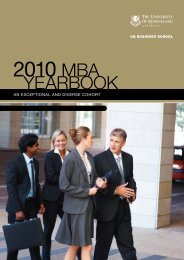Modelling the accruals process and assessing unexpected accruals*
Modelling the accruals process and assessing unexpected accruals*
Modelling the accruals process and assessing unexpected accruals*
You also want an ePaper? Increase the reach of your titles
YUMPU automatically turns print PDFs into web optimized ePapers that Google loves.
Hence, to manage earnings downward (upward), firms can delay (accelerate) <strong>the</strong> recognition of<br />
positive normal <strong>accruals</strong>. As a result, total <strong>accruals</strong> will be lower (higher) than <strong>the</strong> normal<br />
<strong>accruals</strong>, <strong>and</strong> abnormal <strong>accruals</strong> will be (negative) positive. If <strong>the</strong> same level of conservatism<br />
(aggression) is to be maintained across time or firms, more negative (positive) abnormal <strong>accruals</strong><br />
are needed as normal <strong>accruals</strong> increase. In such a setting of no heterogeneity in <strong>the</strong> parameters,<br />
<strong>the</strong>re will be a perfect negative (positive) correlation between abnormal <strong>and</strong> normal <strong>accruals</strong>. 23<br />
5.2 Implications<br />
For well-specified models such as <strong>the</strong> encompassing model <strong>and</strong> <strong>the</strong> modified version of <strong>the</strong><br />
Dechow <strong>and</strong> Dichev (2002) model, my analysis reveals <strong>the</strong>ir resulting <strong>unexpected</strong> <strong>accruals</strong> are<br />
contaminated by two factors – income distortion of <strong>the</strong> benchmark firms <strong>and</strong> deviation in<br />
operating policy between this firm <strong>and</strong> <strong>the</strong> benchmark firms. One necessary condition for<br />
<strong>unexpected</strong> <strong>accruals</strong> to fully capture abnormal <strong>accruals</strong> is that <strong>the</strong> benchmark firms‟ income on<br />
average should be neutral (i.e., m=0). It is no coincidence that this is also one of <strong>the</strong> necessary<br />
conditions that will result in a zero correlation between abnormal <strong>and</strong> normal <strong>accruals</strong> among<br />
firms. On <strong>the</strong> o<strong>the</strong>r h<strong>and</strong>, when <strong>the</strong> income of benchmark firms is on average biased in one<br />
direction (m≠0), abnormal <strong>and</strong> normal <strong>accruals</strong> are correlated. It is also no coincidence that <strong>the</strong><br />
resulting <strong>unexpected</strong> <strong>accruals</strong> under such a condition fail to capture abnormal <strong>accruals</strong> in full 24 .<br />
23 The presence of heterogenity is likely to decrease this perfect correlation. In particular, <strong>the</strong> correlation between<br />
normal <strong>and</strong> abnormal <strong>accruals</strong> is an inverse function of <strong>the</strong> variation in parameters that capture accounting <strong>and</strong> firm<br />
policies among observations. For instance, if <strong>the</strong> variation in accounting (firm) policy is as large as <strong>the</strong> variation in<br />
abnormal (normal) <strong>accruals</strong> among observations, <strong>the</strong> absolute correlation will be reduced to 0.5. If <strong>the</strong> former<br />
variation is lower (larger) than <strong>the</strong> latter, it will be higher (lower) than <strong>the</strong> absolute value of 0.5. The matching<br />
procedure proposed by Kothari et al. (2004) is likely to decrease <strong>the</strong> heterogeneity <strong>and</strong> increase <strong>the</strong> correlation.<br />
24 See section 4.1 for details.<br />
39



